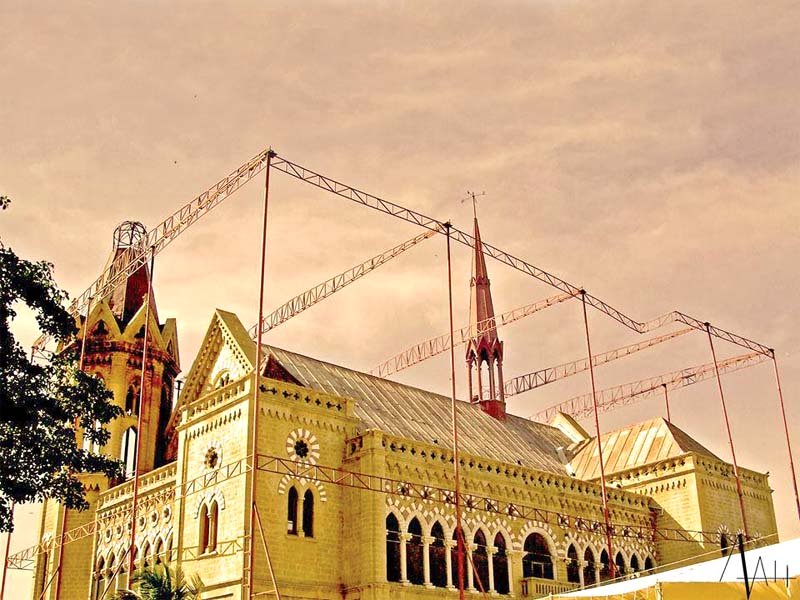
At a time when awareness about ownership of public spaces is growing in the city, the duo is devoting time and energy to bring Karachi's architectural spaces to the fore for public consumption. The young friends, who graduated from NED University in 2015, set up a freelance photography studio, 'Karachi Shutter'. With their lens focused mostly on Karachi, they claim to have documented over 25 projects, including the Allied Bank and LUMS University buildings designed by Habib Fida Ali. Huzaifa is also associated with Habib Fida Ali Architects.
Talking to The Express Tribune, Huzaifa explains how architectural photography is a specialisation and a newly emerging field. "There are a very few architectural photographers," he shares.

Heritage, culture and conservation
According to Huzaifa, the reason they named their studio on Karachi is the inspiration they draw from the city's architecture. "Since I am a graduate of NED University, we were taught a course on preservation of heritage sites," he says. "So, through photography, we try to bring out the cultural aspect of the decline that heritage sites are facing. We bring these problems to the surface by featuring our photographs in architectural magazines."
For the people of Karachi
Huzaifa says that besides architects, the target audience of his photography also includes the common people of Karachi. "Through architectural photography, people get to know about what is going on," he says. "Architecture is not just limited to designing a house for a client in DHA. It's also about the people. If people will accept a space, there perception about it also changes. As of now, there are many cultural aspects that we haven't even started owning."
The young architect talks about his thesis project that was on the revitalisation of Lea Market. "I spent seven nights in Lea Market and realised how much potential the space has," he shares. "There is a clock tower and a bethak [courtyard] and inside there is a circle that can be converted into a neighbourhood garden."
According to him, the space still has the potential to be developed and the need for it can be realised and materialised through his documentation and photography.
"Empress Market was set up for the elite while Lea Market was established for the people working at the seaport," he says. "The space still has the potential to be developed. My thesis project was aimed at providing solutions to urban problems through architecture. I tried bringing out social issues such as mass transit, transportation, hierarchy of stakeholders, settlements and town-planning through architectural photography."
Architectural photography is not just shooting a pretty bungalow, asserts Huzaifa. "Problems with urban planning must be brought to the fore through our work."
According to Huzaifa, architectural community is very limited and there are only a few clients who can afford architects' fee, which is why the socio-cultural aspects are being ventured. "I recently did an exhibition titled 'Kho raha hai Karachi apni tareekh - ek din or ek vaqt [Karachi is losing its history - one day and one time]', and I photographed eight clock towers and three bazaars of Karachi," he shares. The three bazaars were Soldier Bazaar (which was made for soldiers), Empress Market (set up for the elite class of that time) and Lea Market (which was established to cater to the needs of the low-class neighbourhoods), he says. "Through the exhibition, I learnt that people still have an interest in seeing these places."
Conservation of Karachi's history
Huzaifa believes that through his photographs, he is also documenting the history of Karachi as 50 years from now, people can go back to his photographs to see how the city was in these times.
"If you ask me to choose between the building of Atrium mall and Empress Market, I would definitely go with the latter as it has a Gothic architecture and an ambiance that will exist for the next 100 years," he says. "It has its simplicity and speaks the language of Karachi. As an architect, conservationist and an urban planner, I have to think about these places. Who will if not I?"
Huzaifa reiterates that his work is not limited to designing a beautiful building. "The cultural aspect is also emerging," he says. "I want to bring out how our architecture community is also grooming and people should know what's going on. Photography does the job."
Published in The Express Tribune, February 2nd, 2017.




1730360426-0/Menendez-Brothers-(2)1730360426-0-165x106.webp)


















COMMENTS
Comments are moderated and generally will be posted if they are on-topic and not abusive.
For more information, please see our Comments FAQ